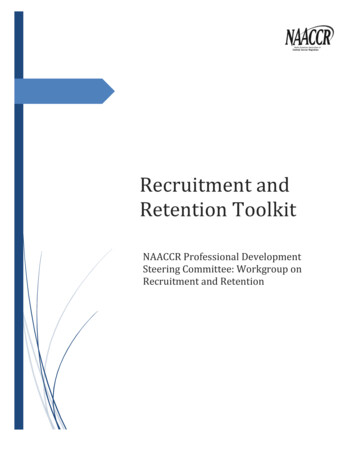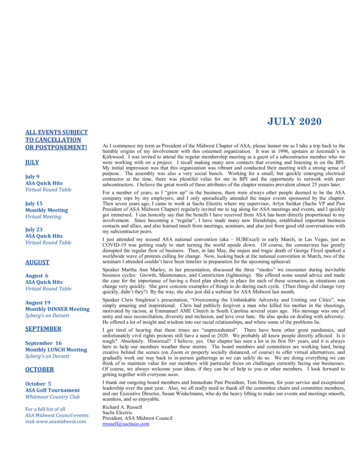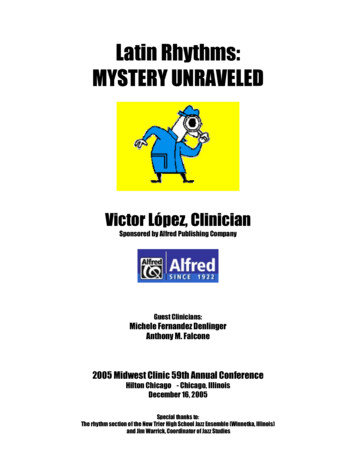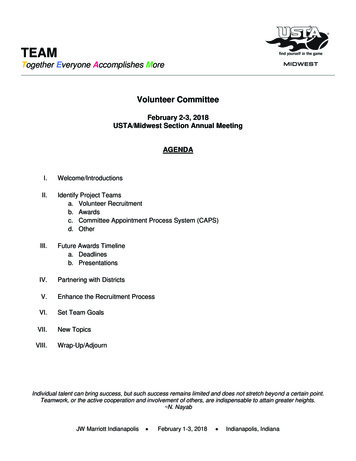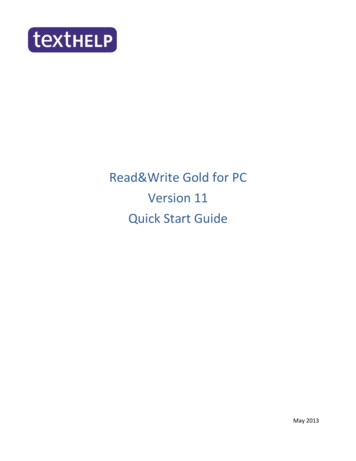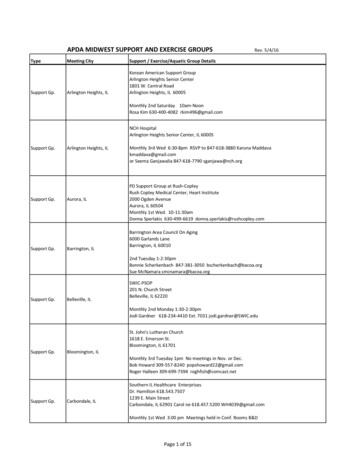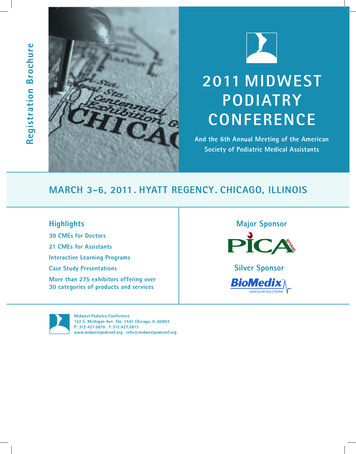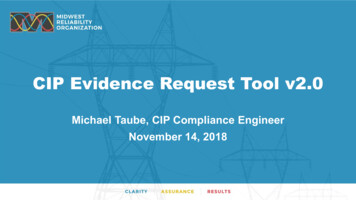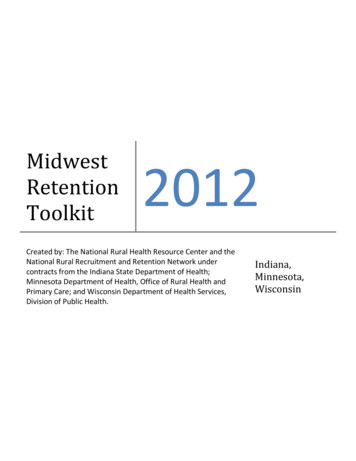
Transcription
MidwestRetentionToolkit2012Created by: The National Rural Health Resource Center and theNational Rural Recruitment and Retention Network undercontracts from the Indiana State Department of Health;Minnesota Department of Health, Office of Rural Health andPrimary Care; and Wisconsin Department of Health Services,Division of Public Health.Indiana,Minnesota,Wisconsin
Midwest National Health Service Corps Retention ToolkitAcknowledgementsOverall planning for the Retention Toolkit and State Resources: Indiana State Department of Health;Minnesota Department of Health, Office of Rural Health and Primary Care; Wisconsin Department ofHealth Services, Primary Care Office; Wisconsin Primary Health Care Association; the National RuralRecruitment and Retention Network (3RNet) and The National Rural Health Resource Center.The Michigan Center for Rural Health, Recruitment and Retention Services is recognized for the manyretention tools contributed to the Midwest Retention Toolkit as well as all 3RNet members and PrimaryCare Offices for creating the strong foundation of rural and underserved recruitment and retentionresources.Funding was provided by the Indiana State Department of Health; Minnesota Department of Health, Officeof Rural Health and Primary Care; and Wisconsin Department of Health Services, Division of Public Healththrough American Recovery and Reinvestment Act grants from the Department of Health and HumanServices, Health Resources and Services Administration, National Health Service Corps (CFDA 93.414).The Midwest National Health Service Corps Retention Toolkit is not intended for commercial use.Permission granted to use within health care facilities for development of individual retention plans.i
For information on the Midwest Retention Toolkit, contact:Indiana State Department of HealthPublic Health and Preparedness CommissionAnn M. AlleyDirector, Office of Primary Care and Rural Health2 North Meridian Street, Section 2JIndianapolis, Indiana v/isdh/20544.htmOffice of Rural Health and Primary CareMinnesota Department of HealthDebra Jahnke, Primary Care CoordinatorP.O. Box 64882St. Paul, MN ://www.health.state.mn.us/divs/orhpc/Wisconsin Department of Health ServicesDivision of Public Health - Primary Care OfficeAnne Dopp, Primary Care Office ici Brockman, Provider Recruitment are/index.htmNikki Kennedy3RNet - National Rural Recruitment and Retention orgSally BuckNational Rural Health Resource CenterAssociate Director600 East Superior St. Suite 404Duluth, MN 55802(218) 727-9390 ext. 225sbuck@ruralcenter.orgwww.ruralcenter.orgii
Table of ContentsFor information on the Midwest Retention Toolkit, contact: . iiIntroduction . 1Retention Issues . 2Midwest NHSC Heath Care Facility Interviews . 2Midwest NHSC Health Care Provider Retention Survey . 2Other Retention and Workforce Reports . 3Top 10 Retention Factors . 3Retention Plan . 4Retention Plan Samples (Sample documents are located at the end of the document) . 41.Michigan Physician Retention Plan . 42.Virginia Department of Health Retention Plan . 43.Quad-state Partnership Basic Three-Year Retention Plan . 4Retention Elements . 4Orientation. 4Orientation/Onboarding Samples . 51.Michigan Center for Rural Health (3 Steps) . 52.National Rural Health Resource Center Orientation Check-Off List. 53.National Rural Health Resource Center Orientation and Retention Overview . 5Practice Feedback Samples . 51. National Rural Recruitment and Retention Network, Recruiting for Retention, 2002, The RetentionQuestionnaire. 5Provider Satisfaction Surveys . 5Provider Satisfaction Survey Samples . 61.Michigan Center for Rural Health, Physician Satisfaction Questionnaire . 62.Quad-state Partnership Sample Clinician Surveys. 63.Mountain States Group Physician Feedback Template. 6Recognition Activities . 6Recognition Activity Samples . 61.Marshfield Clinic Shining Star Program . 6Mentor Programs . 6Mentor Program Samples . 71.Michigan Center for Rural Health, Mentor Program Outline . 7Other Retention Tools . 71.iiiQuad-states Partnership, Sample Exit Interview Form . 7
2.Michigan Center for Rural Health, Physician Exit Interview . 7Financial Retention Samples. 71.Michigan Center for Rural Health, Promissory Note (2-page Word Doc) . 7References . 9Retention Plan Samples. 11Michigan Physician Retention Plan . 11Virginia Department of Health Retention Plan . 14Quad-state Partnership Basic Three-Year Retention Plan . 15Orientation/Onboarding Samples . 18Michigan Center for Rural Health (3 Steps) . 18National Rural Health Resource Center Orientation Check-Off List. 31National Rural Health Resource Center Orientation and Retention Overview . 32Practice Feedback Samples . 38National Rural Recruitment and Retention Network, Recruiting for Retention, The RetentionQuestionnaire . 38Provider Satisfaction Survey Samples . 39Recognition Activity Samples . 49Marshfield Clinic Shining Star Program . 49Shining Star Program Honors Those Who Make a Difference . 49Mentor Program Samples . 49Other Retention Tools . 52Retention Bonus Samples. 55iv
IntroductionThe National Health Service Corps (NHSC) program facilitates connections between primary, dental, andpsychiatric care providers and communities in need by supporting providers who choose to work inunderserved areas of the US. In 2011, the NHSC expanded their Scholarship and Loan Repaymentprograms to include more than 10,000 clinicians providing care to the nation’s underserved communities.The NHSC also provided funding to the State Primary Care Offices (PCOs) in Indiana, Minnesota andWisconsin along with 33 other states to implement two-year projects to support and track the retention ofNHSC health care providers in underserved communities. In the Midwest, Indiana, Minnesota andWisconsin initiated a project to support the retention of NHSC providers in underserved areas bydeveloping a Retention Toolkit of resources to help NHSC sites with provider retention. The NHSC programsupports primary care and psychiatric physicians, physician assistants, advanced practice nurses, mentalhealth providers, dentists and dental hygienists. Similar to a provider’s medical bag, the Retention Toolkithas a variety of instruments or tools for use at each stage of a health care organization’s retention plan.This toolkit includes worksheets, sample surveys, agendas, and plans that may be utilized with all of thesetypes of providers although many of the samples are based on physician retention. The tools ensure theyare properly orientated to the practice, integrated into the community along with their family andrecognized for their service and impact on local health care. The toolkit also features a national and stateresource section with websites and contact information.1
Retention IssuesImmense resources are invested by health care organizations in underserved areas to recruit and trainhealth care providers, therefore it is critical to retain those providers and protect that investment, bothfrom a business and community perspective. For a community, health care provider turnover is disruptiveto health care delivery, continuity of care and patient loyalty. The estimated costs of replacing one primarycare physician can result in 20,000 to 30,000 in recruitment and a loss of 300,000 to 400,000 inannual gross billings plus additional costs related to ancillary employment within the community. 1After ahealth care provider has been recruited, it is critical to understand the challenges they face in providinghealth care in the community and what can be done to support their efforts. Long term retention beginswith recruitment; matching a candidate’s preferences to the attributes of your community will go a longway in ensuring a successful, long term solution to the health care needs of your community. Withoutsuch a foundation, all retention building post-hire will have little impact on retaining a provider who doesnot fit your community.Midwest NHSC Heath Care Facility InterviewsTo identify retention issues and best practices among NHSC sites, the National Rural Health ResourceCenter (The Center) conducted a focus group by phone with 10 site administrators from the three statesrepresenting Federally Qualified Health Centers, Rural Health Clinics, community mental health centersand hospital affiliated primary care clinics from rural and urban areas. Sites indicated the followingretention challenges: lack of individual clinic staff responsibility for retention; limited salary and benefitresources; retaining providers after completion of their loan repayment obligation; and limitedspouse/partner employment opportunities. Some successful retention strategies included affiliations withlocal Universities to offer continuing education and professional networking, creating retentioncommittees, conducting satisfaction surveys, and provider recognition efforts, including a “Provider of theYear” award selected by peers.Midwest NHSC Health Care Provider Retention SurveyTo identify retention factors which were favorable to providers, the Center surveyed 123 health careproviders from IN, MN and WI, with a 48% overall response rate. One third of the respondents weremental health providers, 26% advanced practice nurses, 16% dentists, 12% physicians, 9% physicianassistants and 2% dental hygienists. The respondents were evenly split between rural (52%) and urban(48%) communities with over 20,000 in population. Fifty-five percent had been in the practice two to threeyears and 38% over four years. The majority planned to stay in the practice following completion of theirNHSC obligation, although 26% were not sure they would stay at the site. The most important retentionfactors cited included:Professional relationships with partners and colleaguesWorkload/call e following bullets highlight two particular instances where we discovered clinic retention efforts thatsignificantly misaligned with provider preferences, examples of how important it is to gain provider1Shotwell, Steve. Physician Retention Plan. 2011. Michigan Center for Rural Health2
feedback on what provider’s see as important so as to design incentive offerings that can best addressthose desires:The financial incentives most frequently offered by sites beyond the NHSC loan repaymentincluded: continuing education reimbursement, increasing paid time off and retirement. However,the financial incentives reported to be the most important to providers were increasedcompensation and medical insurance.The providers ranked the recognition activities, community integration and participation inclinic/hospital decision making as most important; however, less than one-third of the sites offeredthese activities. Non-financial strategies typically offered by NHSC sites were provider/satisfactionfeedback surveys, teaching opportunities, and participation in clinic/hospital decision making.Health care providers were asked what else they felt was important that would help encourage them tostay at their current practice site. Survey comments included:Lower case loads or more staff to lower case loads. The work load and expectations tend to causeshigh burnout.Better integration into the community as an individual provider and a practice.I love my job and I couldn’t imagine working anywhere else! The people I work with are great andthe patients make coming to work worthwhile.Other Retention and Workforce ReportsThe South Dakota Department of Health’s Office of Rural Health conducted a Recruitment and RetentionSurvey in May 2012. Health care providers ranked incentives and reasons which they considered to bemost important in their decision to remain practicing in their community. Competitive salary was rated asthe most important issue in the retention of providers. Family oriented setting; educational facilities forchildren; incentives (bonuses, health insurance and sick leave); and employment opportunities forspouse/partners also ranked very high.2A workforce study conducted among social workers in North Dakota found that 47% indicated that“burnout/stress” was the least enjoyable aspect of their job and “not being able to pay a competitivesalary” was seen as the most serious problem related to recruitment and retention of social work staff. 3Top 10 Retention FactorsAs noted in the survey, focus groups and previous studies, a number of factors impact retention. Acomprehensive retention plan should address all of the following factors (not ranked) as much as feasiblefor the site and community:Availability of relief coverage for vacations, holidays and family emergencies.Quality of public elementary and secondary schools.Compatibility with others in health care community.Availability of quality housing.Availability of practice partners and consulting specialists.2South Dakota Department of Health Office of Rural Health Recruitment and Retention Study. May 2012.North Dakota Social Work Workforce Report, Quinn, A., Phillips, A., Heitkamp, T. University of North Dakota Department ofSocial Work, November 2011.33
Income potential.Employment opportunities for spouse/partner.Help with retiring education loans at start of practice.Availability of continuing education opportunities.Opportunity to be a preceptor.Retention PlanThe core component of health care provider retention is to maintain regular contact with new providersand their families to stay informed of their community and workplace adjustment, and to mitigate anypotential problems that could impact retention. Retention begins as soon as a provider signs an agreementor accepts an employment offer and continues throughout the length of their practice. A formal retentionplan including scheduled professional and community interactions and staff accountable for those tasks isrecommended. One person should be designated to coordinate or oversee the plan; however, acommittee approach to implementation can be considered. The key components of the Retention Planshould include:1.2.3.4.5.Goals, timeline and person accountableCommittee or those part of the planResources (materials, community and health care contacts, and budget)Elements of RetentionEvaluation (outcome measures)Retention Plan Samples (Sample documents are located at the end of the document)1. Michigan Physician Retention PlanAn introduction to retention and a plan outlined into 3 steps (3-page Word Doc)2. Virginia Department of Health Retention PlanAn action plan with steps (1-page Word Doc)3. Quad
Survey in May 2012. Health care providers ranked incentives and reasons which they considered to be most important in their decision to remain practicing in their community. Competitive salary was rated as the most important issue in the retention of provi
